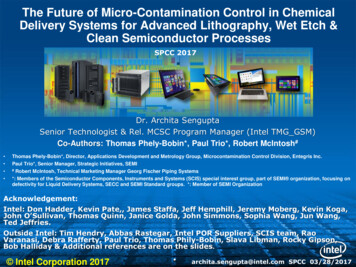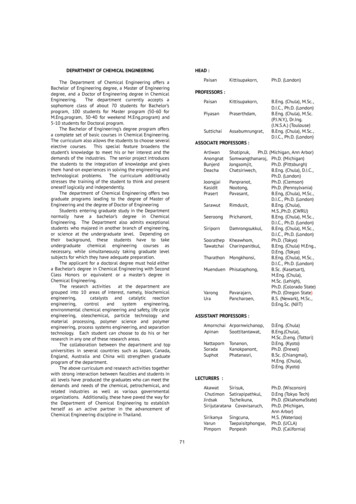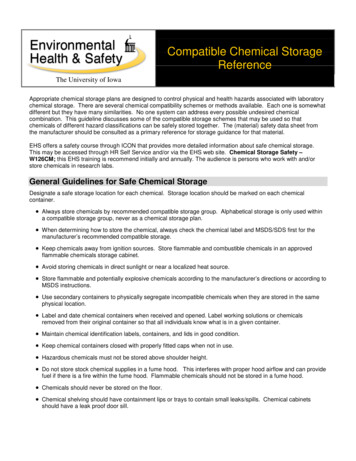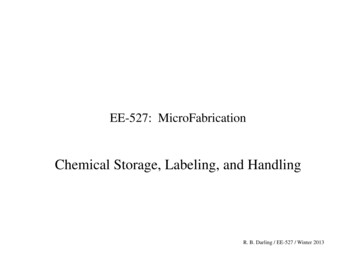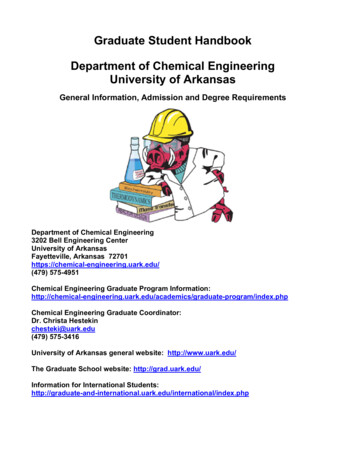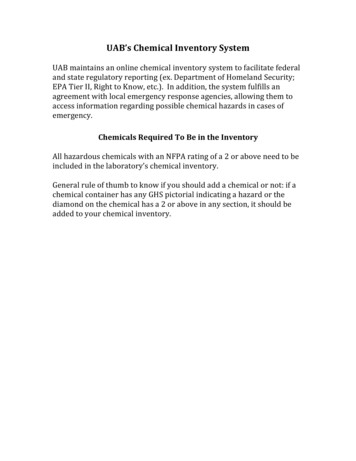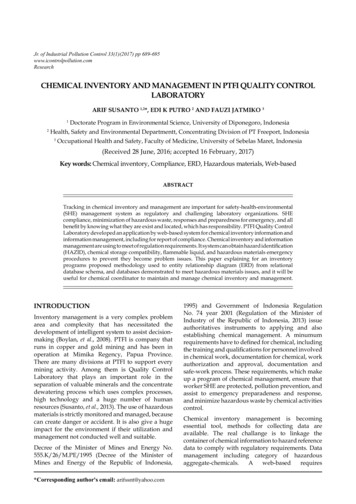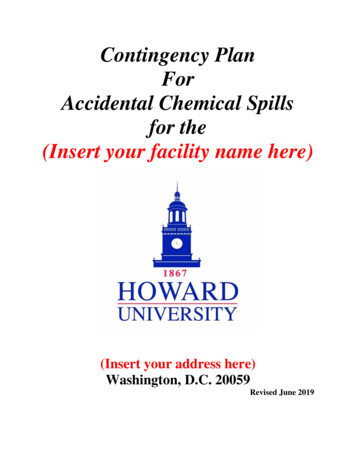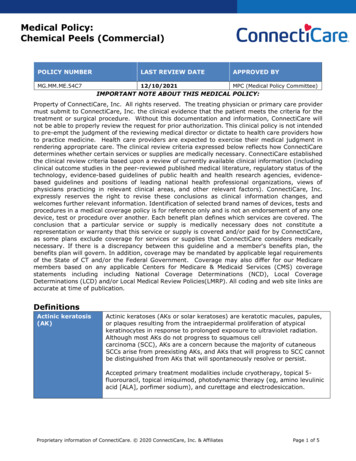
Transcription
Medical Policy:Chemical Peels (Commercial)POLICY NUMBERLAST REVIEW DATEAPPROVED BYMG.MM.ME.54C712/10/2021MPC (Medical Policy Committee)IMPORTANT NOTE ABOUT THIS MEDICAL POLICY:Property of ConnectiCare, Inc. All rights reserved. The treating physician or primary care providermust submit to ConnectiCare, Inc. the clinical evidence that the patient meets the criteria for thetreatment or surgical procedure. Without this documentation and information, ConnectiCare willnot be able to properly review the request for prior authorization. This clinical policy is not intendedto pre-empt the judgment of the reviewing medical director or dictate to health care providers howto practice medicine. Health care providers are expected to exercise their medical judgment inrendering appropriate care. The clinical review criteria expressed below reflects how ConnectiCaredetermines whether certain services or supplies are medically necessary. ConnectiCare establishedthe clinical review criteria based upon a review of currently available clinical information (includingclinical outcome studies in the peer-reviewed published medical literature, regulatory status of thetechnology, evidence-based guidelines of public health and health research agencies, evidencebased guidelines and positions of leading national health professional organizations, views ofphysicians practicing in relevant clinical areas, and other relevant factors). ConnectiCare, Inc.expressly reserves the right to revise these conclusions as clinical information changes, andwelcomes further relevant information. Identification of selected brand names of devices, tests andprocedures in a medical coverage policy is for reference only and is not an endorsement of any onedevice, test or procedure over another. Each benefit plan defines which services are covered. Theconclusion that a particular service or supply is medically necessary does not constitute arepresentation or warranty that this service or supply is covered and/or paid for by ConnectiCare,as some plans exclude coverage for services or supplies that ConnectiCare considers medicallynecessary. If there is a discrepancy between this guideline and a member's benefits plan, thebenefits plan will govern. In addition, coverage may be mandated by applicable legal requirementsof the State of CT and/or the Federal Government. Coverage may also differ for our Medicaremembers based on any applicable Centers for Medicare & Medicaid Services (CMS) coveragestatements including including National Coverage Determinations (NCD), Local CoverageDeterminations (LCD) and/or Local Medical Review Policies(LMRP). All coding and web site links areaccurate at time of publication.DefinitionsActinic keratosis(AK)Actinic keratoses (AKs or solar keratoses) are keratotic macules, papules,or plaques resulting from the intraepidermal proliferation of atypicalkeratinocytes in response to prolonged exposure to ultraviolet radiation.Although most AKs do not progress to squamous cellcarcinoma (SCC), AKs are a concern because the majority of cutaneousSCCs arise from preexisting AKs, and AKs that will progress to SCC cannotbe distinguished from AKs that will spontaneously resolve or persist.Accepted primary treatment modalities include cryotherapy, topical 5fluorouracil, topical imiquimod, photodynamic therapy (eg, amino levulinicacid [ALA], porfimer sodium), and curettage and electrodesiccation.Proprietary information of ConnectiCare. 2020 ConnectiCare, Inc. & AffiliatesPage 1 of 5
Medical Policy:Chemical Peels (Commercial)Chemical peelControlled removal of varying layers of the skin with use of causticchemical agents; resulting in a thinner, more compact stratumcorneum, thicker epidermis, and uniform distribution of melanin. Peels aretypically categorized according to dept and agent usedDepthVery superficial(see Limitations/Exclusions)Superficial(See Limitations/Exclusions)AgentsGlycolic acid, 30-50 percent applied for 1-2minutesJessner (resorcinol, salicylic acid, lacticacid, ethanol) solution applied in 1-3 coatsLow concentration resorcinol, 20-30 percentapplied for 5-10 minutesTCA (trichloroacetic acid) 10 percent applied in1 coatGlycolic acid, 50-70 percent, applied for 2-5minutesPyruvic acid, 40-50 percent applied for 3-5minutesJessner solution applied in 4-10 coatsResorcinol, 40-50 percent applied for30-60 minutesTCA, 10-30 percentMediumDeepGlycolic acid 70 percent applied for 3-15minutesPyruvic acid 60 percent applied for 3-5minutesTCA, 35-50 percentAugmented TCA (carbon dioxide and TCA 35percent; Jessner solution and TCA 35 percent;glycolic acid 70 percent and TCA 35 percent)Phenol 88 percentBaker-Gordon phenol formula (88 percentphenol, distilled water, septisol, croton oil)Fabbrocini G, De Padova MP, Tosti A. Chemical peels: what's new and what isn't new but stillworks well. Facial Plast Surg 2009; 25:329.Related GuidelineCosmetic Surgery ProceduresPhototherapy, Photochemotherapy and Photodynamic Therapy for DermatologicConditionsGuidelineMedium or deep chemical peels are considered medically necessary for 10 actinic keratoses (orother premalignant skin lesions) due to the impracticality of treating large numbers of al peels are not considered medically necessary for the treatment of active acneProprietary information of ConnectiCare. 2020 ConnectiCare, Inc. & AffiliatesPage 2 of 5
Medical Policy:Chemical Peels (Commercial)vulgaris due to insufficient evidence of therapeutic value.2.Chemical peels are not considered medically necessary when for the following cosmeticpurposes (list not all-inclusive):a. Acne scarring (case-by-case review when documentation substantiating medicalnecessity is submitted to the plan)b. Contouring/discoloration/hyperpigmentation (e.g., dermatosis papulosa nigra,rosacea)c. Dull complexityd. Ephelides (freckles)e. Fine/fewer lines and wrinklesf. Lentigines (liver spots; aka age spots)g. Melasmah. Photoaged skini. Sebaceous hyperplasia (aka senile hyperplasia)j. Seborrheic keratosesk. Skin roughnessApplicable Procedure Codes15788Chemical peel, facial; epidermal15789Chemical peel, facial; dermal15792Chemical peel, nonfacial; epidermal15793Chemical peel, nonfacial; dermalApplicable Diagnosis CodesD48.5Neoplasm of Uncertain Behavior of SkinL57.0Actinic keratosisReferencesCleveland Clinic. Common Benign Growths. June bs/diseasemanagement/dermatology/commonbenign- growths/Default.htm. Accessed December 21, 2021.Branham GH, Thomas JR. Rejuvenation of the skin surface: Chemical peel and dermabrasion. FacialPlast Surg. 1996;12(2):125-133.Brodland DG, Roenigk RK. Tricholoroacetic acid chemexfoliation (chemical peel) for extensivepremalignant actinic damage of the face and scalp. Mayo Clin Proceed. 1988;63(9):887-896.Criscione VD, Weinstock MA, Naylor MF, et al. Actinic keratoses: Natural history and risk of malignanttransformation in the Veterans Affairs Topical Tretinoin Chemoprevention Trial. Cancer 2009;115:2523.Demas PN, Bridenstine JB, Braun TW. Pharmacology of agents used in the management of patientshaving skin resurfacing. J Oral Maxillofac Surg. 1997;55(11):1255-1258.Proprietary information of ConnectiCare. 2020 ConnectiCare, Inc. & AffiliatesPage 3 of 5
Medical Policy:Chemical Peels (Commercial)de Berker D, McGregor JM, Hughes BR. Guidelines for the management of actinic keratoses. Br JDermatol 2007; 156(2):222-30.Dreno B, Fischer TC, Perosino E, et al. Expert opinion: Efficacy of superficial chemical peels in activeacne management --what can we learn from the literature today? Evidence-based recommendations. JEur Acad Dermatol Venereol. 2011;25(6):695-704.Fulton JE Jr. Dermabrasion, chemabrasion, and laserabrasion. Historical perspectives, moderndermabrasion techniques, and future trends. Dermatol Surg. 1996;22(7):619-628.Giese SY, McKinney P, Roth SI, Zukowski M. The effect of chemosurgical peels and dermabrasion ondermal elastic tissue. Plast Reconstr Surg. 1997;100(2):489-500.Fabbrocini G, De Padova MP, Tosti A. Chemical peels: what's new and what isn't new but still workswell. Facial Plast Surg 2009; 25:329.Godin DA, Graham HD 3rd. Chemical peels. J La State Med Soc. 1998;150(11):513-520.Gupta AK, Inniss K, Wainwright R, et al. Interventions for actinic keratoses (Protocol for CochraneReview). Cochrane Database Syst Rev. 2003;(4):CD004415.Gutling M. Chemical peel--current possibilities and limits. Ther Umsch. 1999;56(4):182-187.Handog EB, Datuin MS, Singzon IA. Chemical peels for acne and acne scars in Asians: Evidence basedreview. J Cutan Aesthet Surg. 20125(4):239-246.Humphreys TR, Werth V, Dzubow L, Kligman A. Treatment of photodamaged skin with trichloroaceticacid and topical tretinoin. J Am Acad Dermatol. 1996;34(4):638-644.Jerant AF, Johnson JT, Sheridan CD, Caffrey TJ. Early detection and treatment of skin cancer. Am FamPhysician. 2000;62(2):357-368, 375-376, 381-382.Khunger N, Sarkar R, Jain RK. Tretinoin peels versus glycolic acid peels in the treatment of Melasma indark-skinned patients. Dermatol Surg. 2004;30(5):756-760; discussion 760.Khunger N; IADVL Task Force. Standard guidelines of care for chemical peels. Indian J DermatolVenereol Leprol. 2008;74 Suppl:S5-S12.Lee SH, Huh CH, Park KC, Youn SW. Effects of repetitive superficial chemical peels on facial sebumsecretion in acne patients. J Eur Acad Dermatol Venereol. 2006;20(8):964-968.Monheit GD. Medium-depth chemical peels. Dermatol Clin. 2001;19(3):413-425, vii. Montemarano AD.Melasma. eMedicine Dermatology Topic 260. Omaha, NE: eMedicine.com;updated June 25, 2003.Morganroth GS, Leffell DJ. Nonexcisional treatment of benign and premalignant cutaneous lesions. ClinPlast Surg. 1993;20:91-104.National Comprehensive Cancer Network. NCCN Guidelines Squamous Cell Skin Cancer. in.aspx?ReturnURL https://www.nccn.org/professionals/physician gls/pdf/squamous.pdf. Accessed December 21, 2021.Perras C. Imiquimod 5% cream for actinic keratosis. Issues in Emerging Health Technologies. Issue 61.Ottawa, ON: Canadian Coordinating Office for Health Technology Assessment (CCOHTA); 2004.Roenigk RK, Brodland DG. A primer of facial chemical peel. Dermatol Clin. 1993;11(2):349-359.Proprietary information of ConnectiCare. 2020 ConnectiCare, Inc. & AffiliatesPage 4 of 5
Medical Policy:Chemical Peels (Commercial)Rubin MG. A peeler's thoughts on skin improvement with chemical peels and laser resurfacing. ClinPlast Surg. 1997;24(2):407-409.Samuel M, Brooke RCC, Hollis S, Griffiths CEM. Interventions for photodamaged skin. CochraneDatabase Syst Rev. 2005;(1):CD001782.Simonart T. Newer approaches to the treatment of acne vulgaris. Am J Clin Dermatol.2012;13(6):357-364.Specialty matched clinical peer review.Steinsapir KD. The chemical peel. Int Ophthalmol Clin. 1997;37(3):81-96.Strauss JS, Krowchuk DP, Leyden JJ, et al. American Academy of Dermatology. Guidelines of care foracne vulgaris management. J Am Acad Dermatol. 2007;56-651-653.Tse Y, Ostad A, Lee HS, et al. A clinical and histologic evaluation of two medium-depth peels. Glycolicacid versus Jessner's trichloroacetic acid. Dermatol Surg. 1996;22(9):781-786.Van Scott EJ, Yu RJ. Alpha hydroxy acids: Procedures for use in clinical practice. Cutis. 1989;43:222228.Witheiler DD, Lawrence N, Cox SE, et al. Long-term efficacy and safety of Jessner's solution and 35%trichloroacetic acid vs 5% fluorouracil in the treatment of widespread facial actinic keratoses. DermatolSurg. 1997;23(3):191-196.Revision historyDATEREVISION01/01/2020New policy. Connecticare has adopted the clinical criteria of its parentcorporation, Emblem Health.Proprietary information of ConnectiCare. 2020 ConnectiCare, Inc. & AffiliatesPage 5 of 5
Applicable Procedure Codes . 15788 Chemical peel, facial; epidermal 15789 Chemical peel, facial; dermal 15792 Chemical peel, nonfacial; epidermal 15793 Chemical peel, nonfacial; dermal . Applicable Diagnosis Codes . D48.5 Neoplasm of Uncertain Behavior of Skin L57.0 Actinic keratosis . References . Cleveland Clinic. Common Benign Growths. June .

